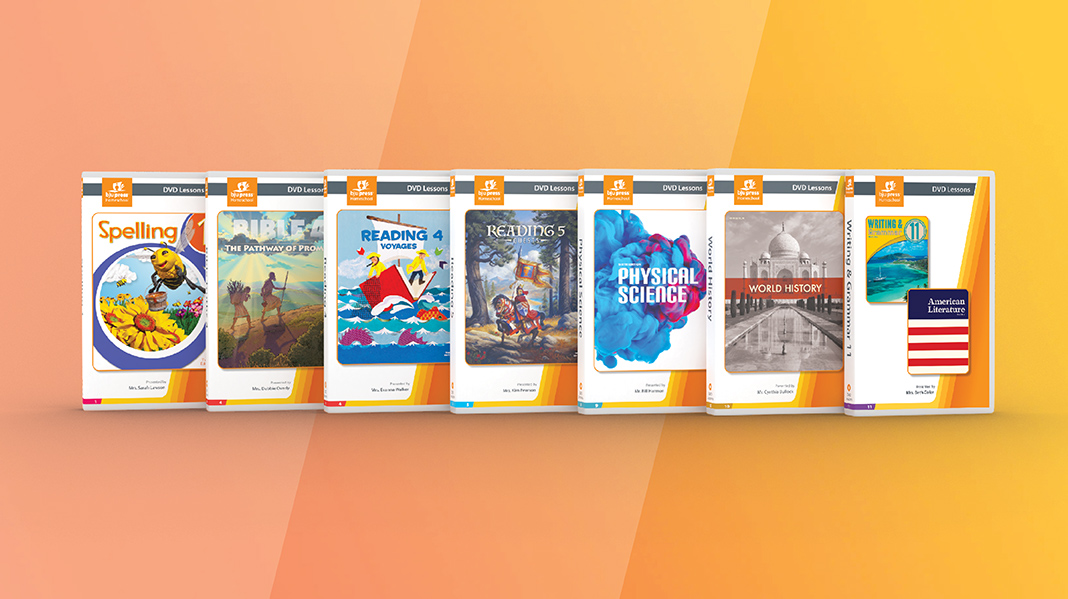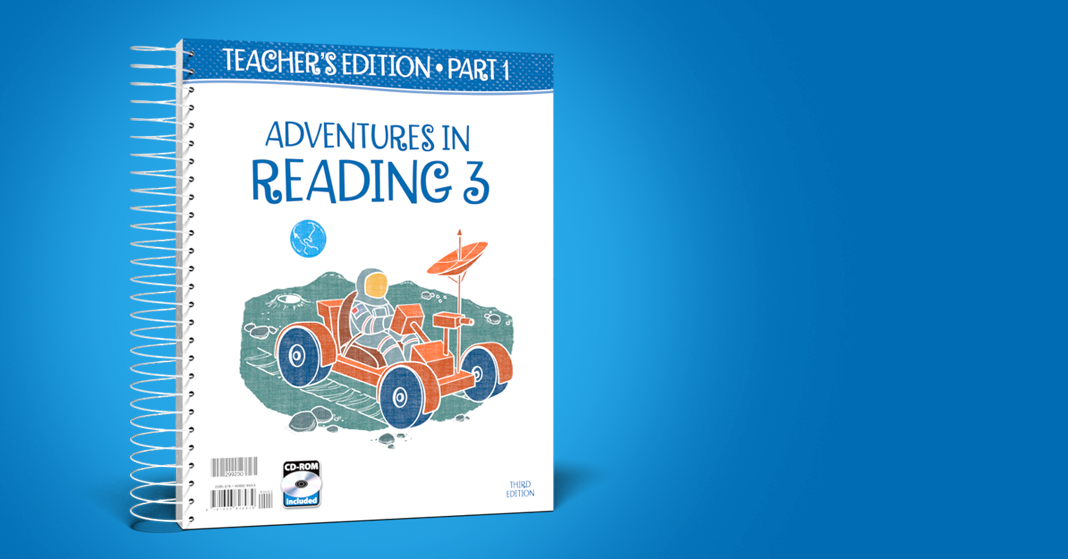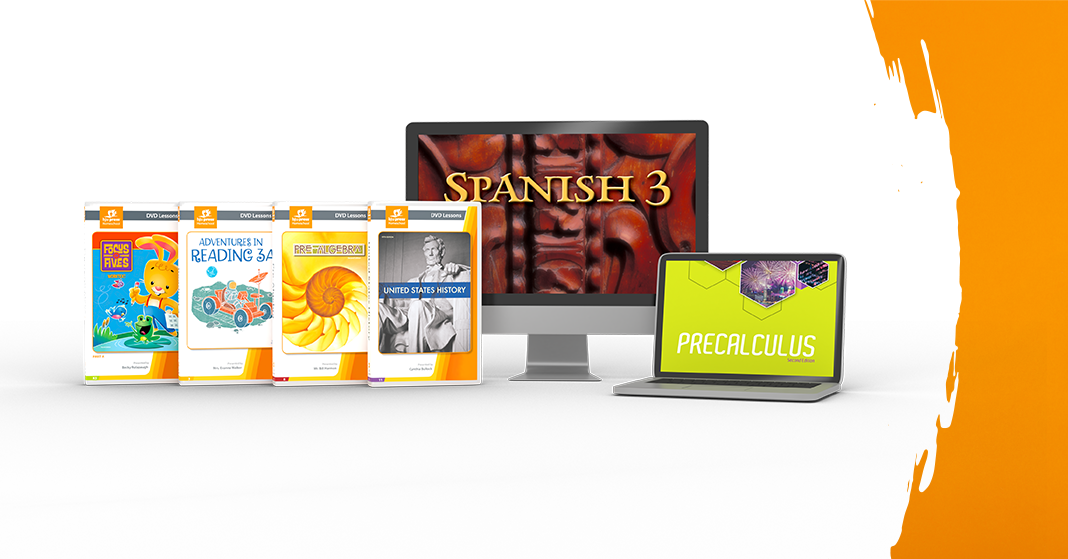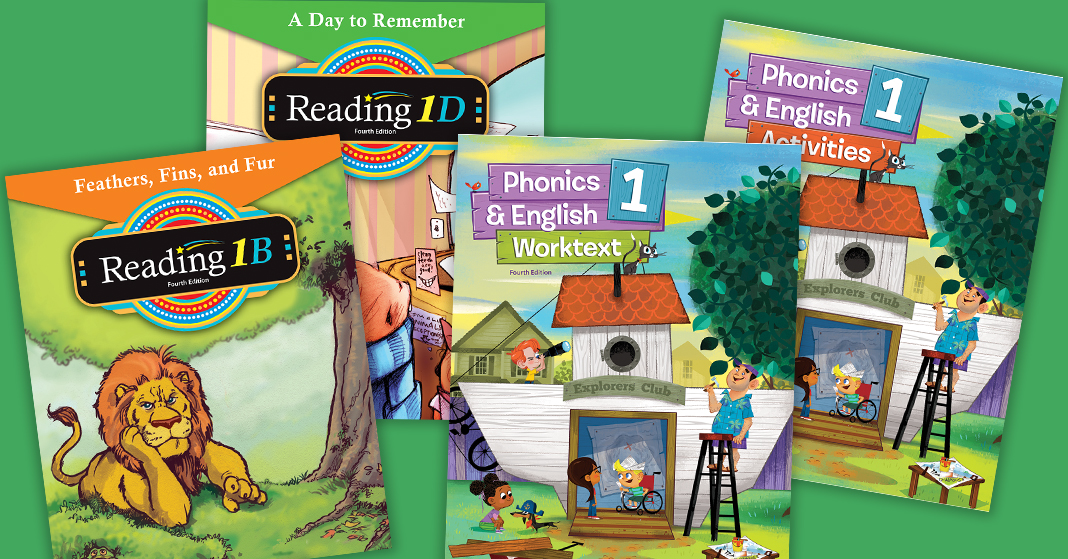
We are excited to introduce our new video courses for 2021! This year we have seven new courses that span from Grades 1–11. Each course is age-appropriate and, above all, is designed to excite a love of learning in your students. For more information about these new courses, see our new 2021 Catalog! [Read more…] about New Homeschool Video Courses
reading
Why We Study Literature

When I was in elementary, I spent hours hiding away in libraries, reading as much as I could before my parents made me leave. Looking back on my life, I can see how certain books shaped who I am today. Most people have at least one book that has profoundly influenced them. If reading has this much power, then learning to study literature is one of the most important parts of a child’s development. Reading is so much more than just understanding what words mean. It has the ability to shape children’s minds and experiences in positive ways.
How to Use Teacher Editions in Your Homeschool

Like many of you, I am in the process of figuring out my homeschool curriculum order for our next school year. I’m trying to decide what Distance Learning subjects and textbook kits we want to order, what textbooks and teacher’s materials we can reuse from older children, and what “extras” we need. But there’s something that’s definitely going in my order—the teacher editions for any subjects that I plan to teach myself.
I don’t buy printed teacher editions for every subject. My children use Distance Learning Online for many of their subjects, so I have access to the digital teacher editions for those courses if I ever need them. But I teach Reading 3 to my second daughter and Focus on Fives to my third daughter. I have found the teacher editions for those courses to be invaluable.
Let me walk you through my Reading 3 Teacher Edition to show you why I love it so much.
Clear Planning
Like all BJU Press teacher editions, Reading 3 includes a Lesson Plan Overview in the front of each volume. The Lesson Plan Overview gives me a bird’s-eye view of the course. I can see how many lessons we’ll spend on any particular selection and what skills we’ll be focusing on. I use this to help me build my homeschool calendar, but I always end up making adjustments. Sometimes I end up combining lessons or skipping lessons altogether (yes, it’s okay to skip lessons!) based on what else is happening in our homeschool.
Individual Lesson Guides in Teacher Editions
Every lesson in Reading 3 has been carefully thought out. When I open my teacher edition to an individual lesson, I have everything that I need to teach effectively.
Objectives
A glance at the top of the page tells me what pages we’re going to cover in the student textbook or worktext. The lesson objectives are clearly stated so I know exactly what my daughter needs to know by the end of the lesson. And I can clearly see what materials I need for the lesson and where I can find them.
Routine
Each lesson has a routine. We start with going over the vocabulary words that my daughter will need to know in order to understand what she’s reading. Each vocabulary word is presented in context so that my daughter will learn how to use context clues to figure out the meaning of unknown words when she comes across them in her own reading.
Reading Focus
Next we move on to our reading focus, which is the literary skill that the lesson is focusing on developing (like recognizing how the setting impacts the story). Here, the teacher edition provides instructions on how to introduce these skills and questions that I can ask my daughter to make sure that she understands the instruction.
Reading Selections
Then we jump into the selection itself. The teacher edition provides me with reduced student pages, so I can see exactly what my daughter sees in her student textbook. But I get a few extra features. All the vocabulary words for this particular lesson are underlined in the text so that I can make sure my daughter understands them. I also get some additional notes that help me with biblical worldview shaping and text enrichment.
Guiding Questions
The biggest help for me is the questions and answers that the teacher edition provides. These questions, as I wrote in a previous post, help me develop and assess my daughter’s reading comprehension, and they also help me lead my daughter to have a deep appreciation for the selection. I know from experience that I would not be able to come up with questions like these on my own. Do I ask every question? No. Some we skip because of time. Some I end up expanding because of my daughter’s interest. Remember that the teacher edition is just a guide—you don’t have to do everything. You don’t even have to ask each question exactly as written. You are in charge. The teacher edition is just there to provide support.
Phonics Review
By the time you teach Reading 3, your child should have a good foundation of phonics knowledge. But many third graders (mine included) still need additional phonics practice. So every lesson in Reading 3 includes a review of a phonics principle, and most worktext pages assess that same phonics skill. Don’t feel as if you always have to teach that portion of the lesson. If your child breezes through that portion of the worktext page without mistakes, just move on.
Grading Resources
The teacher edition does include reduced student pages of the worktext pages (with answers), but they are very small. A digital copy of the worktext answer key is included on the CD that comes free with the teacher edition and a printed edition is available for separate purchase.
The CD contains a few other grading tools. The most valuable to me is the rubric that helps me assess my daughter’s oral reading.
Other Resources in Teacher Editions
The CD that comes with the teacher edition contains a wealth of other resources such as teaching aids and additional activities. These are particularly helpful for multisensory teaching. Find the ones that are useful for you and your child and ignore the rest.
While we have been focusing on the teacher edition for Reading 3, all BJU Press teacher materials include the same kinds of helpful resources for teaching your children. Some include a resource CD, some offer multiple volumes of teaching material, and some have online resources available. A teacher edition is one of the most valuable tools that you will find in your homeschool toolbox. But don’t feel bound to it. It is designed to help support you, so make it work for you and your homeschool situation.
If you are interested in previewing any of BJU Press’s teacher editions online, just click the Look Inside button at the bottom of the product image.
New Homeschool Video Courses

New video courses are available for homeschool families! Each course includes age-appropriate segments, opportunities for hands-on learning, and video demonstrations. We’re excited to use some colorful new textbooks and materials with several of these courses. If you’d like to get a sneak peek at these courses, we’ll be introducing them all on our Facebook page, and you can look for the sample videos on our website!
Upcoming Video Courses for 2020
Focus on Fives with Mrs. Rulapaugh
This past year, Megan—one of our blog writers—had an opportunity to use the new Focus on Fives materials with her daughter for K5. Because of her experience with the textbooks, she’s had a wonderful time with her daughter. On the other hand, the video course gives you an opportunity for the same experiences with the added benefit of having a teacher. This new video course takes advantage of the materials for an exciting introduction to early learning. Mrs. Rulapaugh, who also teaches K5 Math, prepares her students for first grade with lessons in phonics and reading as well as heritage studies and science. This course is absolutely packed with exciting video segments that keep kids engaged and learning. It has animated stories and songs, biblical themes, phonics stories, science explorations, activities with Hopscotch, and more.
A day’s worth of lessons averages 60 minutes, but children will have many opportunities for breaks, games, and activities that keep them having fun. Mrs. Rulapaugh is excited to help her students love learning!
Reading 3 with Mrs. Walker
Kids who enjoyed Reading 2 with Mrs. Walker will be excited to join her again for Reading 3! This course uses Adventures in Reading 3 (3rd edition) with a travel theme. Mrs. Walker wants to inspire wonder and discovery in her students as she embarks on thoughtful discussions about each reading. As they journey through the material, children will have an opportunity to practice critical thinking and phonics skills. In this reading adventure, each lesson will include colorful segments of animated poems, story times, and more. As always, Mrs. Walker ends her lessons with a giggle to bring fun and joy to learning!
Pre-Algebra with Mr. Harmon
In this new Pre-Algebra video course, Mr. Harmon seeks to help students understand math by using simple explanations with real-life examples. Students will expand on the concepts they learned with him in Fundamentals of Math so that they can be prepared for Algebra 1. Math-Splaining segments use an illustrative approach to explain difficult math concepts for students.
United States History with Mrs. Bullock
A history class should be far more than a dry recitation of dates and facts. Mrs. Bullock encourages her students to get into the minds of historic figures so they can consider the thoughts and attitudes that led to events in American history. In addition to knowing the facts, she also wants her students to ask why things happened the way they did. This course uses the new United States History (5th edition) materials and covers history from the discovery of the American continents through to the present day. Mrs. Bullock includes segments that offer glimpses into the lives of American families, present unique historical perspectives, bring primary source documents to life, and provide dramatic readings of speeches.
Spanish 3 with Mrs. Kuhlewind
This course builds on the principles Mrs. Kuhlewind introduced in Spanish 2 and continues to help students develop skills in speaking, reading, listening, and writing. Her goal is for her students to become comfortable with a new language so that they can have confidence in using their new language skills. To that end, Mrs. Kuhlewind’s segments offer opportunities for Spanish listening and vocabulary building. The segments also provide introductions to Spanish cultures, architecture, cooking, and dialects.
Please note that this course will only be available as an online video course. A DVD option will not be available at this time.
Precalculus with Mr. Matesevac
The key to success in advanced mathematics is perseverance. Mr. Matesevac encourages his students to press on to master the challenging concepts of Precalculus so that they will develop wisdom and maturity. For students who apply themselves, this course provides a solid foundation for college-level math. Students will use the new Precalculus (2nd edition) materials which balance study of the foundations of calculus with practical, real-world applications. Mr. Matesevac works out difficult problems through Math Applied video segments to give students a different perspective on each problem.
Please note that this course will only be available as an online video course. A DVD option will not be available at this time.
Our team has been working hard to develop these video courses and fill each lesson with useful segments. We can’t wait to share them with you and your children! Which course are you most excited for?
Choosing Curriculum to Encourage Confident Readers

It’s wonderful to have options when you’re teaching your children. When something doesn’t work, you can always try something else and keep at it until your kids get what you’re teaching. So a lot of homeschool families wind up using curriculum from a bunch of different publishers for a single grade. And it works. But BJU Press has designed certain subjects to support each other in unique ways. Specifically, students who use Phonics and English 1 and Reading 1 together will be better equipped to be confident readers.
In K5, all of English language arts are integrated—you teach it all together. But in Grade 1, English and reading count as separate subjects. They’re separate, but they still correlate. The concepts and progression of skills support each other in both subjects. If you use a different curriculum for English or reading, then your child will miss the benefits of a correlated reading program and may find learning to read harder than it needs to be.
Opportunities for Practice and Review
Practice and review opportunities are an intrinsic part of each BJU Press textbook. Children need to see concepts repeatedly to develop automaticity—the ability to do something without thinking about it, or automatically. But when they’re just learning to read, children need more practice and review opportunities of the phonetic concepts they learn in English than are provided in the textbook itself. Reading 1 follows the same progression of skills as Phonics & English 1, so that children will find more opportunities for practice and review of concepts they learned in English while doing their reading books.
Application Skills
What’s the difference between practice and application? When we’re practicing a concept, we’re usually seeing the exact same concept over and over again. The more we see it, the more familiar it will be. But application is actually a little different. Application introduces a familiar concept in a new situation. It gives us a chance to apply what we know to figure out what we don’t know. It’s a critical thinking skill that most of us use regularly even if we don’t realize it. Because Phonics & English 1 and Reading 1 correlate to introduce and develop concepts at the same time, children will not only learn a new concept, but also have the opportunity to apply it.
For example, a phonics lesson might introduce the _at word family. Your child has practiced reading the words at, cat, and bat as a part of the phonics lesson. Later, in his reading lesson, he finds a new word, hat. Because he knows the h sound and he knows the _at word family, he can apply what he knows about the two sounds and read the new word. As he learns to recognize new words based on what he knows, his confidence in reading grows.
Please note that, while the progression of concepts do correlate, the lesson numbers don’t always correlate. There are fewer reading lessons than there are phonics lessons. This helps children to stay ahead in phonics and to master concepts in reading. We have created a correlation chart to show you which lessons you should be teaching together.
Prepared to Be Confident Readers
When English and reading lessons support each other by adding practice and application, your child will be better prepared to learn new skills and concepts going forward. First, she learns the skills she needs to be successful in Phonics and English 1. Then, she learns to use and expand on those skills in Reading 1. When she comes back for another English lesson, she’ll be prepared for it because she’s had time and opportunity to practice and apply what she learned before. She’ll have more confidence and certainty about what she knows in both English and reading.
Dangers of Mixing Curriculum
But what can happen if your English curriculum and reading curriculum don’t support each other? Your English materials may not prepare your children adequately for what they’ll encounter in reading, and their reading program may not give them the practice and application they will need to be confident in their phonics and English lessons. Programs that don’t correlate often introduce skills at different times. Children who are constantly running into new skills that they aren’t prepared for will either become overwhelmed by learning, or they’ll resort to guessing. Guessers can easily become confused and frustrated when they don’t understand why their guesses are right or wrong.
It’s easier to encourage your children to become lifelong readers when they have confidence in reading. Children who become confident readers are more equipped for success because they will be better prepared for the reading challenges they will face in later grades.